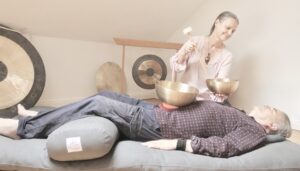by Alex Andrzejewski
Stress is a well known problem of today’s world. It has been proven to cause a variety of disorders and diseases, both physical and mental, and it affects people from all walks of life. Everyone experiences stress in it’s various forms, and some of us even suffer the consequences of a long term stressful environment in our lives.
It is said that the individual response to stress varies due to a person’s own resources and ways of coping with stress.
Some theorists now refer to the healthy state as one of stability in the face of change. Multiple causes of stress add to what is called allostatic loading, which can be pathologic if not relieved.(1)
Once the individual is subjected to long term stress, his or her resources are depleted, and the response to stressful stimuli may be disproportionately pronounced.
It is also said that various relaxation techniques play a large role in regeneration of our resources; and relaxation techniques, as a remedy for stress, is one of the most researched subjects. Two of the most commonly recommended relaxation methods are yoga and meditation. Also, various techniques using sound are starting to play a bigger role in stress relief – in particular, sound therapy.
What is a sound massage?
 Sound therapy consists of placing the sound (singing) bowls on or around the body and gently striking them to create sound and vibration. Multi-tonal sound envelops the client and practitioner, creating a relaxing and safe environment. At the same time, the gentle vibrations of the sound bowl extend to all parts of the body, consequently massaging every cell, tissue and organ on the deepest level.
Sound therapy consists of placing the sound (singing) bowls on or around the body and gently striking them to create sound and vibration. Multi-tonal sound envelops the client and practitioner, creating a relaxing and safe environment. At the same time, the gentle vibrations of the sound bowl extend to all parts of the body, consequently massaging every cell, tissue and organ on the deepest level.
The client is a passive receiver of this treatment; however, the effect is profound in all aspects of body and mind. Due to the soft nature of sound vibrations, the body receives them as a gentle, balmy breeze. All body tissues vibrate, making detoxification, tissue repair and healing easier.(3)
This [vibration] causes a tone regulation of () muscle, slightly promoting blood circulation, thus enhancing the metabolism.(4)
The effects of this treatment on the mind are even more pronounced. To explain those, I need to throw a little light on the nature of the sounds emitted by sound (singing) bowls.
According to researchers, “…the singing bowls emit complex non-harmonic multi- tonal sounds with components gathering in the characteristic groups producing binaural beats at frequencies placed mainly below the acoustic zone of [the] mechanical resonance band of the human organs as well as alpha and theta brain frequencies.” (5) Which means that the sound (singing) bowls produce a combination of sounds with some below human hearing range, matching brain waves found in relaxation and sleep modes (alpha and theta waves), thus physically producing a relaxation effect. And as a research study by K. Gommel showed, the effects of relaxation (prevalence of alpha waves in ECG scans) are long lasting. (6)
This effect is produced automatically on the physical level, and the receiver does not need to learn a process or technique to take full advantage of this relaxing influence. Better still, because the sound of the bowls so quickly and inadvertently create the state of relaxation, a person living with stress can experience and learn a stress free condition during sound massage.
Meditation, in comparison, is an active relaxation. Even though the object of meditation is to be silent and find inner peace and stillness, a certain amount of training is required to achieve such states.
Meditation is a practice in which an individual trains the mind or induces a mode of consciousness, either to bring about some benefit or as and end in itself.(7)
Although there is no doubt that meditation is an exceptional remedy to stress, it also requires a certain level of ability to practice. And although it is available to all people, there are those who claim,for one reason or another, to be unable to meditate. Often, those are people who are so stressed, that their mind is in constant activity. They find it very difficult to concentrate their thoughts on one subject, and every time they try to meditate, they either fall asleep or start thinking about their daily problems. These individuals have a feeling of failure after the attempted meditation session. They may try a few times, then unfortunately never come back to the practice.

The benefits of sound with meditation have been known for many centuries and it has been used in various settings where chanting, singing and sounds of instruments helped to induce meditative states. Sound massage is a modern version of this ancient knowledge.”
So, to bring those who are unable to succeed right away to the practice of meditation, it could help to start with the practice of sound massage, with the purpose of relieving the most severe aspects of stress. After several sessions, depending on the severity of the stress reactions, it would be easier for the individual to relax, and in consequence, learn meditation.
As is done in the best traditions of holistic healing, we connect all aspects of body and mind through sound and meditation.
References:
1. Sound Therapy Induced Relaxation: Down Regulating Stress Processes and Pathologies, Elliott Salamon, and Minsun Kim, John Beaulieu, and George B. Stefano. http://www.biosonics.com
2. http://www.maranta.com.au/sound-massage/
3. Cell and sound. M. Pabst Journal of European Association for Sound Massage Therapy 9/2010
4. Beneficial Sound Massage. Ch. Koller PhD, Journal of European Association for Sound Massage Therapy
5. The acoustic field of the singing bowls – method of visualisation. A. Meyer, H. Portalska, M. Portalski, A. Konieczka and J. Balcerek. “Elektronika” 3/2009
6. The neural effects of Peter Hess ® sound massage, Dr Kerstin Gommel PhD
7. Wikipedia
©2014Maranta Sound Academy


Leave a Reply